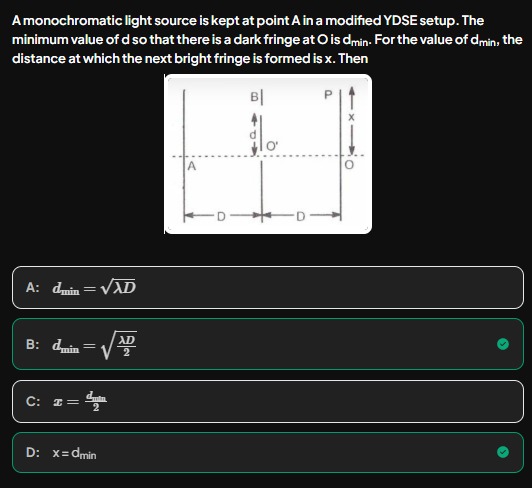Question
Question: A monochromatic light source is kept at point A in a modified YDSE setup. The minimum value of d so ...
A monochromatic light source is kept at point A in a modified YDSE setup. The minimum value of d so that there is a dark fringe at O is dmin. For the value of dmin, the distance at which the next bright fringe is formed is x. Then

dmin=λD
dmin=2λD
x=2dmin
x=dmin
Option B (for dmin=2λD) and Option D (for x=dmin)
Solution
-
Extra Illumination phase:
The lower slit at O′ is at distance D from the source A, while the upper slit B, being at a vertical separation d, is at distance approximately
≈D+2Dd2
so the phase difference due to illumination is
ϕill=λ2π⋅2Dd2.
-
Path Difference to the Observation Point O:
At point O (on the same horizontal through A and O′) the two waves travel different distances. The extra path from B (relative to O′) is also approximately
2Dd2.
Thus the phase difference due to propagation is
ϕprop=λ2π⋅2Dd2.
-
Total Phase Difference at O:
Adding the two contributions:
ϕtotal=λ2π(2Dd2+2Dd2)=λD2πd2.
For a dark fringe at O (destructive interference), we require
λD2πd2=π,
which gives
d2=2λD⟹dmin=2λD.
This confirms Option B.
-
Next Bright Fringe:
As the interference pattern from the two slits is shifted (since the central fringe is dark), the conditions for bright fringes become:
ϕtotal(y)=λD2πd2−λD2πdy=2πm.
For the next bright fringe (taking m = 1 and noting that at y = 0 we had ϕ=π), one finds after setting up the equation and substituting dmin that
x=y=dmin.
This confirms Option D.
